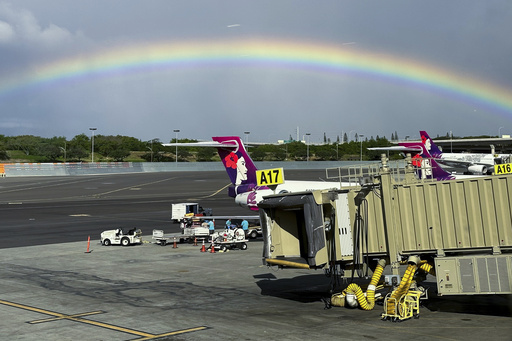
HONOLULU — Hawaii’s warm sunny days, sporadic rain showers, and pristine air create exceptional conditions for observing rainbows. One professor from the University of Hawaii has even dubbed the islands the “rainbow capital of the world.”
Currently, Hawaii is in its winter rainy season, which increases the likelihood of encountering these beautiful arcs of color.
In Hawaii, rainbows have become an iconic representation of island culture. They are so common that images of rainbows can be found on various forms of local architecture, public buses, and even vehicle license plates. Additionally, the University of Hawaii’s sports teams proudly carry the rainbow name.
Liane Usher, president of the Children’s Discovery Center in Honolulu, expressed her feelings toward rainbows, stating, “For me, rainbows really signify hope and new beginnings. I can’t ever help but smile whenever I see a rainbow after the rain.”
Understanding where to spot these vivid natural phenomena is crucial. Rainbows occur when sunlight is refracted by raindrops, creating a vivid display of colors. One can witness a rainbow when both sunshine and rain coincide, typically appearing opposite the sun. During mornings and late afternoons, when the sun is closer to the horizon, rainbows appear larger and higher in the sky. Steven Businger, a professor of atmospheric sciences at the University of Hawaii at Manoa, noted that the islands’ trade winds often bring passing showers, allowing clear skies for sunlight to pierce through. Hawaii’s exceptionally clean air further enhances rainbow visibility, as many other locations deal with air particles from dust and pollution. Notably, this phenomenon is bolstered during the rainy season from October to April.
According to Businger, “Hawaii has maybe the best rainbows on the planet,” and he has developed an app called RainbowChase to aid residents and visitors in discovering these vibrant displays. Interestingly, the Hawaiian language has about 20 terms for rainbows, encompassing specific words for various types, such as their fragments and those near the horizon.
Rainbows hold significant meaning within Native Hawaiian culture as well. They symbolize divine powers, as expressed by Sam ‘Ohu Gon III, a senior scientist and cultural adviser at The Nature Conservancy in Hawaii. He explained that rainbows represent K?ne, one of the four primary Hawaiian gods, and that approaching a rainbow might lead one to encounter supernatural forces or notable individuals. In a traditional tale, a rainbow is recorded to have appeared over the home of a Hawaiian princess for four consecutive days, signifying the arrival of a powerful suitor. For Hinaleimoana Wong-Kalu, a teacher and cultural practitioner, seeing a rainbow signifies the presence of “aumakua,” or ancestral spirits who provide guidance and protection, reassuring her that she is loved and watched over.
Over time, rainbows have become synonymous with Hawaiian identity. They are prominently featured in various designs, from building facades to athletic uniforms. The University of Hawaii’s men’s sports teams are known as the Rainbow Warriors, while the women’s teams, referred to as Rainbow Wahine, utilize the Hawaiian term for women. The nickname for these teams, “Bows,” is now widely recognized. The origins of this association trace back to a New Year’s Day game in 1924 when a rainbow appeared just as the local team scored, leading reporters to nickname them the Rainbows. Though the Hawaii football team dropped “Rainbow” from its name in 2000 due to concerns related to stigma, it was reinstated in 2013.
The impact of climate change on rainbows is a subject of study as well. Kimberly Carlson, a former professor at Manoa, sparked her interest in this topic after witnessing a rainbow outside her window. Now teaching at New York University, she has examined potential changes over the next century. Her research finds that regions like Brazil, the Mediterranean, and parts of Central Africa may see fewer rainbows by 2100. However, areas that typically experience more snowfall and are shifting towards increased rain, such as Alaska, could observe a rise in rainbow occurrences.
Despite the projections, scientists believe Hawaii will maintain a plentiful rainbow presence. Yet, there may be fewer rainbows in the drier leeward sides of the islands due to extended dry periods, particularly affecting regions like Maui and the Big Island. Businger emphasized the need to study rainbows, stating that they serve as a cultural touchstone, allowing people to pause and appreciate the moment. “Rainbows cause us to stand still and for a moment, forget about the past and the future,” he said. “We are really in the moment when we see a spectacular rainbow, and that’s a rare experience in our busy lives.”

